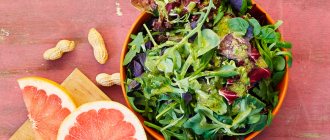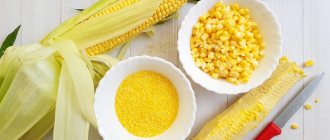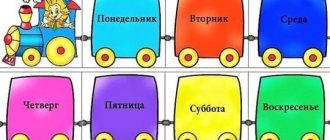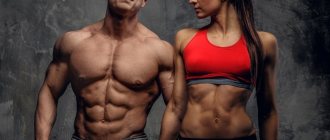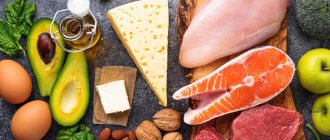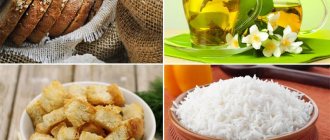A no-carbohydrate diet, as the name implies, is an eating regimen in which the amount of carbohydrates consumed is radically limited. Many different types of nutrition are based on limiting carbohydrates, with the creation of corresponding menus: from Montignac and Dukan to the keto diet . All of the above is called a low-carbohydrate diet for weight loss.
At the same time, the number of calories consumed remains the same as always. This allows you not to reduce the amount of energy spent per day.
A diet without carbohydrates is intended only and exclusively for weight loss . Unlike therapeutic diets, completely healthy people use carbohydrate-free diets. This is necessary so that the diet does not cause an exacerbation of existing diseases.
General rules
What is a no-carb diet?
A no-carbohydrate diet, despite the total restriction of carbohydrates, is one of the most effective and comfortable nutrition plans.
A similar system was initially recommended for athletes who are professional bodybuilders and perform in competitions. But the technique quickly went beyond the boundaries of professional sports and, it turned out, perfectly helps those who are not a fan of intense physical activity. A diet without carbohydrates allows you to get rid of subcutaneous fat as much as possible and leave behind only beautiful muscle definition and reduced weight. Carbohydrates are, of course, not completely excluded from the diet: their amount per day should not exceed 30-40 g. This is the most comfortable option for safe and painless weight loss on a carbohydrate-free diet. For comparison, the above-mentioned professional athletes most often use a strict option - limiting the amount of carbohydrates to 15-20 g per day. But, think for yourself, do you need it?
According to some researchers, a low-carbohydrate diet still requires some amount of carbohydrates for the normal functioning of the gastrointestinal tract in order to avoid constipation . But other experts say that with this diet, it is indeed possible to completely eliminate carbohydrates and reduce their consumption to zero and this will not bring any harm. This is a natural process: less food comes in, accordingly, the volume of feces decreases, and you go to the toilet less often. In addition, absolute abstinence from carbohydrates is the most effective in the case of this diet.
Here, the main products that make up the carbohydrate-free menu are meat, dairy products and eggs. Rarely and in very small quantities, vegetables and cereals - no more than 30-40 g per day.
Don't worry about going hungry. It's not like that at all! The volumes and sizes of food that does not contain carbohydrates are not measured; it can be eaten in any quantity. Of course, you shouldn't go heavy on fatty steaks. It is better to give preference to chicken, turkey, beef, veal, rabbit, duck - meat that is not too fatty or lean. When preparing dishes, of course, you need to avoid large amounts of salt and oil.
Also, you need to gain the very necessary amount of carbohydrates from whole grain cereals and green vegetables, which will provide you with beauty and lightness, and not from buns and chocolate. In addition, consuming sweets and sugar, even in the smallest amount, causes a sharp jump in blood sugar, which leads to outbreaks of hunger and metabolic failure.
The diet is safe for most people, but it is worth remembering that a prolonged deficiency of carbohydrates, firstly, can affect the functioning of the brain and nervous system; secondly, an abundant intake of proteins into the body requires mandatory physical activity. Of course, it is not necessary to play sports professionally, but basic strength physical activity, basic exercises and cardio training are vital for noticeable weight loss and a beautiful body.
What happens in the body when you give up carbohydrates?
A no-carb diet is also called a keto diet . This is due to the fact that carbohydrate starvation activates a process called ketosis - the body's breakdown of fat cells with the formation of a significant amount of ketone bodies for energy.
The transition to ketosis on a no-carb diet occurs gradually:
Stage I
You consumed carbohydrates in the morning and then do not consume them at all. This will begin the first stage of energy supply, during which the body will consume the glucose it received in the morning meal.
This supply will run out after a few hours, and the body will then begin to use up glycogen stores (your body's stored carbohydrate reserves), more and more over time, to convert it into glucose, which will provide the body with energy.
Stage II
The second stage is that glucose is no longer supplied from food, and the body uses glycogen . After 2-3 days, the body will understand that the lack of carbohydrates is only increasing and will begin to use an alternative source of energy in a larger volume. This will make the fat burning process even more effective.
Stage III
This stage occurs after 3-4 days and is due to the fact that there is practically no glycogen left in the body. So, only proteins and fats remain for the body. Fats are burned, but ketosis is not yet fully established, and proteins are also used to provide the body with energy.
In this regard, the amount of protein consumed in the first week of the diet should be several times higher than the amount intended for subsequent weeks. It looks like this: per 1 kg of weight in the first week of a carbohydrate-free diet there should be 3-4 g of protein.
Stage IV
After a week, the body realizes that carbohydrates will no longer be supplied, and begins to take energy from fat. Thus, the process of ketosis .
Experts say that a circular version of a carbohydrate-free diet is the most effective, does not require intensive training and allows you to live, work and maintain physical activity even with a diet.
Features of a low-carbohydrate diet for diabetics, athletes, vegetarians and pregnant women
Diabetes mellitus is a disease that causes many complications. To prevent them, you must follow some rules. Proper nutrition is one of them. Snacking and an unbalanced diet with this diagnosis leads to obesity and numerous other problems. A low-carbohydrate diet for weight loss, helps type 1 and type 2 diabetics.
A diet for patients with type 1 diabetes (insulin is administered by injection) is an excellent way to lose excess weight, as well as to stabilize blood sugar levels. For type 2, this diet is no less important. Eating fiber significantly slows down the process of fat absorption. Prevents obesity and reduces blood sugar levels.
Using a low-carb diet in conjunction with exercise can help you lose 200 to 400 grams per week.
A protein diet is often used by athletes in order to “dry out.” Drying is a process during which subcutaneous fat is removed, preserving muscle mass, making the body beautiful and sculpted. This happens due to abundant protein consumption. The maximum carbohydrate intake during the drying period is 250 kcal. During a high-protein diet, baked goods and fats are excluded.
Proteins are consumed per 1 kg of body weight, 2.5 kg of protein (daily). Divide the diet into 5 meals. To avoid health problems (vitaminosis), you need to take minerals and vitamins during your diet. Vegetarianism excludes the consumption of animal protein. But that doesn't mean vegetarians can't try a low-carb diet.
Meat, dairy products, fish are replaced:
- analogues from soy;
- beans;
- cereals.
During pregnancy, a woman's body is completely rebuilt. Proper nutrition is important for the health of the expectant mother and her baby. A strict low-carbohydrate diet is prohibited for pregnant women.
Excessive protein intake can cause kidney and liver problems. This may lead to undesirable consequences. Only by the second trimester can you think about a non-strict protein diet.
Types of low-carbohydrate diet
No-carbohydrate diet permanent
The amount of carbohydrates tends to zero. Usually there are no more than 20 of them per day in the form of fiber. Such a constant diet contains a minimal amount of carbohydrates, but a lot of fat and protein. Such regular restriction of carbohydrates is fraught with “inhibited” reactions, dissipation of attention, and decreased brain activity.
Low-carbohydrate diet
This option is suitable for avid athletes: it is necessary to consume a little carbohydrates before each workout so that you have the strength and energy for full physical work in the gym. In this case, it is important to really devote a lot of time to physical activity, because if you do not expend less energy than you consumed, you will not lose weight.
Low-carbohydrate diet circular (most effective)
The essence of this variety is that for 6 days you do not consume carbohydrates (with the exception of those 30-40 g in the form of cereals and vegetables, you can eat them) and the body switches to using fat reserves. And on the 7th day (Sunday) you “load up” with carbohydrates: you eat a full diet of cereals, vegetables, durum wheat pasta, and you can even eat fruit in the first half of the day.
Carbohydrate loading is needed in order to launch the production of enzymes, increase metabolism, and saturate muscles with glycogen. All this is so that you feel good for the next week, work fully, engage in sports and mental activity.
Drinking regimen during the keto diet
Since such a diet involves reducing foods containing fiber (cereals, vegetables, fruits), water becomes the main stimulator of peristalsis. This important element of the diet is intended not only to remove undigested food from the intestines, but is also an important component of the full generation of cells in a losing weight.
With a low-carbohydrate diet, you need to drink 1.5-2 liters of plain water. In addition, you are allowed to drink no more than a liter of green tea without sugar per day. Coffee should not be abused, although you can drink it every few days, but without sugar.
How long can you stay on a low-carbohydrate diet?
On a lighter version of a carbohydrate-free diet, for the “unprepared”, with an estimate of 30-40 g of carbohydrates per day, you can sit for 2 to 6 weeks. In a week the weight will be about 3-4 kg. Of course, the duration of the diet should be based on your well-being and health.
Basic diet rules
This program was developed specifically for bodybuilders participating in competitions and championships, but, like many other nutrition systems, it went beyond the framework of professional sports.
Protein foods and a small amount of vegetable fats are the main emphasis of this diet. Limiting the amount of carbohydrates, although maximum, is not complete. It is still advisable to consume 30-40 g of carbohydrates per day for normal functioning of the intestines and stomach. Excluding them completely from the diet increases the risk of developing constipation and other digestive disorders.
What can you eat on a low-carbohydrate diet (Allowed foods)
Allowed and recommended foods for a low-carbohydrate diet include, of course, meat. From boiled chicken breast to camel meat.
The most popular:
- poultry meat - chicken, turkey;
- fish - trout, mackerel, salmon, cod, herring, flounder and tuna;
- red meat - rabbit, veal, beef, lamb, rarely - pork, since such meat is too fatty;
- dairy products - kefir, milk, cottage cheese, cheese containing about 5% protein, fermented baked milk, sour cream.
A strict version of the diet is the exclusion of fruits, vegetables and cereals, or their consumption in very small quantities. But, if this is your first time on such a diet, experts still advise including these products in your menu.
So, only a few fruits are allowed: all citrus fruits, peaches, sour apples and coconut. You can make juices, add them to cereals, use them as a snack, or eat them separately.
Some vegetables are also allowed, mostly all green: celery, cucumbers, peppers, lettuce, basil, parsley, dill, white cabbage, cilantro, arugula. Zucchini, eggplant, and beans are great for heat-treated side dishes, which, by the way, contain a lot of protein.
Nuts are very healthy! In addition to the fact that they are rich in protein, nuts contain healthy fats that make your hair, nails, skin beautiful, and are responsible for external beauty and sparkle in your eyes. You just need to regularly (2-3 times a week) eat a handful of walnuts, peanuts, cashews, almonds, hazelnuts, and pistachios.
Include cereals in your diet at least several times a week: buckwheat, peas, cilantro, oatmeal - all these cereals are rich in proteins and, at the same time, contain the necessary fiber.
Lastly, keep an eye on your condition. If you experience depression, slow thinking, loss of concentration, little vitality and energy, then you most likely have a carbohydrate deficiency and should add more to your diet.
A carbohydrate-free diet menu should be built on the basis of this table of carbohydrates:
| Product/Dish | Amount of carbohydrates (in grams) | |
| Fish, seafood (100 g) | Boiled | 3 |
| Salted herring | 2 | |
| Smoked herring | 4 | |
| Squid | 4 | |
| Shrimps | 0 | |
| Smoked salmon | 0 | |
| Dairy products (100 g) | Cottage cheese | 3 |
| Sour cream (200 g) | 10 | |
| Kefir, yogurt without sugar (250 g) | 13 | |
| Cheeses (different varieties) | 0,5-2 | |
| Milk (250 g) | 6 | |
| Eggs | In any form | 0,5 |
| Fat (20 g) | Butter | 1 |
| Mayonnaise | 1 | |
| Margarine | 1 | |
| Vegetable oil | 0 | |
| Vegetables (100 g) | Carrot | 5 |
| Canned tomato | 4 | |
| Eggplant | 3 | |
| Fresh tomato (medium size) | 6 | |
| Fresh cucumber | 5 | |
| Pickled cucumber | 2 | |
| Onion (1 pc.) | 8 | |
| Chopped green onion (1 tbsp.) | 5 | |
| Radishes (6 pcs.) | 0.5 | |
| Zucchini | 4 | |
| Beetroot (1 pc.) | 6 | |
| Mushrooms | 5 | |
| Green beans | 8 | |
| Boiled cauliflower | 6 | |
| Fresh cabbage | 5 | |
| Sauerkraut | 3 | |
| Nuts (2 tbsp) | Peanut | 1,8 |
| Hazelnut | 1,2 | |
| Almonds (100 g) | 11 | |
| Cedar | 1,7 | |
| Fruit (1 pc.) | Apricot | 3 |
| Plum | 8 | |
| Mandarin, lemon | 6 | |
| Apple | 18 | |
| Orange | 17 | |
| Pear | 25 | |
| Peach, kiwi | 9 | |
| Berries | Cranberries (1 tbsp.) | 8 |
| Cherry | 16 | |
| Blueberry | 21 | |
| Raspberries | 17 | |
| Black currant | 19 | |
| Juices (250 g) | Apple, tomato, grape | 10 |
| Meat (100 g) | Boiled | 0 |
| Fried in breadcrumbs | 5 | |
| With flour sauce | 6 | |
| Steak | 1 | |
| Sausages, sausage, ham | 1 | |
| Boiled chicken | 0 | |
| Pork goulash | 9 | |
| Veal goulash | 2 | |
| Beef stew | 5 | |
| Beef liver | 6 | |
| Chop | 0 | |
Table of permitted products
| Proteins, g | Fats, g | Carbohydrates, g | Calories, kcal | |
Vegetables and greens | ||||
| eggplant | 1,2 | 0,1 | 4,5 | 24 |
| peas | 6,0 | 0,0 | 9,0 | 60 |
| zucchini | 0,6 | 0,3 | 4,6 | 24 |
| cabbage | 1,8 | 0,1 | 4,7 | 27 |
| broccoli | 3,0 | 0,4 | 5,2 | 28 |
| cabbage | 1,2 | 0,2 | 2,0 | 16 |
| cilantro | 2,1 | 0,5 | 1,9 | 23 |
| leek | 2,0 | 0,0 | 8,2 | 33 |
| bulb onions | 1,4 | 0,0 | 10,4 | 41 |
| cucumbers | 0,8 | 0,1 | 2,8 | 15 |
| olives | 0,8 | 10,7 | 6,3 | 115 |
| squash | 0,6 | 0,1 | 4,3 | 19 |
| sweet green pepper | 1,3 | 0,0 | 7,2 | 26 |
| parsley | 3,7 | 0,4 | 7,6 | 47 |
| radish | 1,2 | 0,1 | 3,4 | 19 |
| arugula | 2,6 | 0,7 | 2,1 | 25 |
| salad | 1,2 | 0,3 | 1,3 | 12 |
| asparagus | 1,9 | 0,1 | 3,1 | 20 |
| tomatoes | 0,6 | 0,2 | 4,2 | 20 |
| dill | 2,5 | 0,5 | 6,3 | 38 |
| garlic | 6,5 | 0,5 | 29,9 | 143 |
| lentils | 24,0 | 1,5 | 42,7 | 284 |
Fruits | ||||
| oranges | 0,9 | 0,2 | 8,1 | 36 |
| grapefruit | 0,7 | 0,2 | 6,5 | 29 |
| lime | 0,9 | 0,1 | 3,0 | 16 |
| lemons | 0,9 | 0,1 | 3,0 | 16 |
| tangerines | 0,8 | 0,2 | 7,5 | 33 |
| peaches | 0,9 | 0,1 | 11,3 | 46 |
| pomelo | 0,6 | 0,2 | 6,7 | 32 |
| sweetie | 0,7 | 0,2 | 9,0 | 58 |
| apples | 0,4 | 0,4 | 9,8 | 47 |
Nuts and dried fruits | ||||
| cashew | 25,7 | 54,1 | 13,2 | 643 |
| coconuts | 3,4 | 33,5 | 6,2 | 354 |
| almond | 18,6 | 57,7 | 16,2 | 645 |
| pistachios | 20,0 | 50,0 | 7,0 | 556 |
| hazelnut | 16,1 | 66,9 | 9,9 | 704 |
Cereals and porridges | ||||
| buckwheat | 4,5 | 2,3 | 25,0 | 132 |
| quinoa | 14,1 | 6,1 | 57,2 | 368 |
Dairy | ||||
| skim milk | 2,0 | 0,1 | 4,8 | 31 |
| kefir 1% | 2,8 | 1,0 | 4,0 | 40 |
| sour cream 10% (low-fat) | 3,0 | 10,0 | 2,9 | 115 |
| Ryazhenka 1% | 3,0 | 1,0 | 4,2 | 40 |
| natural yogurt 2% | 4,3 | 2,0 | 6,2 | 60 |
Cheeses and cottage cheese | ||||
| cheese | 24,1 | 29,5 | 0,3 | 363 |
| cottage cheese 0% (low fat) | 16,5 | 0,0 | 1,3 | 71 |
Meat products | ||||
| pork | 16,0 | 21,6 | 0,0 | 259 |
| pork liver | 18,8 | 3,6 | 0,0 | 108 |
| beef | 18,9 | 19,4 | 0,0 | 187 |
| beef liver | 17,4 | 3,1 | 0,0 | 98 |
| beef kidneys | 12,5 | 1,8 | 0,0 | 66 |
| beef heart | 15,0 | 3,0 | 0,0 | 87 |
| beef tongue | 13,6 | 12,1 | 0,0 | 163 |
| beef brains | 9,5 | 9,5 | 0,0 | 124 |
| veal | 19,7 | 1,2 | 0,0 | 90 |
| mutton | 15,6 | 16,3 | 0,0 | 209 |
| rabbit | 21,0 | 8,0 | 0,0 | 156 |
| venison | 19,5 | 8,5 | 0,0 | 154 |
| horsemeat | 20,2 | 7,0 | 0,0 | 187 |
| bacon | 23,0 | 45,0 | 0,0 | 500 |
| ham | 22,6 | 20,9 | 0,0 | 279 |
| cutlets | 16,6 | 20,0 | 11,8 | 282 |
| steak | 27,8 | 29,6 | 1,7 | 384 |
| pork meatballs | 7,0 | 10,0 | 12,0 | 172 |
Bird | ||||
| chicken | 16,0 | 14,0 | 0,0 | 190 |
| turkey | 19,2 | 0,7 | 0,0 | 84 |
| duck | 16,5 | 61,2 | 0,0 | 346 |
Eggs | ||||
| omelette | 9,6 | 15,4 | 1,9 | 184 |
| chicken eggs | 12,7 | 10,9 | 0,7 | 157 |
| quail eggs | 11,9 | 13,1 | 0,6 | 168 |
Fish and seafood | ||||
| flounder | 16,5 | 1,8 | 0,0 | 83 |
| salmon | 19,8 | 6,3 | 0,0 | 142 |
| mackerel | 20,7 | 3,4 | 0,0 | 113 |
| herring | 16,3 | 10,7 | — | 161 |
| cod | 17,7 | 0,7 | — | 78 |
| tuna | 23,0 | 1,0 | — | 101 |
| trout | 19,2 | 2,1 | — | 97 |
Oils and fats | ||||
| vegetable oil | 0,0 | 99,0 | 0,0 | 899 |
Non-alcoholic drinks | ||||
| lingonberry juice | 0,1 | 0,0 | 10,7 | 41 |
| green tea | 0,0 | 0,0 | 0,0 | — |
| * data is per 100 g of product | ||||
Table of permitted products
A low-carbohydrate diet for weight loss (a menu for every day, a table of allowed foods is presented below) is an excellent way to combat excess weight. The variety of foods makes this nutrition program easy and affordable.
| Meat products | Lean beef, pork, lamb, veal, chicken, turkey, duck, goose, rabbit, beef and pork tongue, chicken liver, turkey liver, heart, chicken eggs. |
| Fish and seafood | Seabass, halibut, pink salmon, catfish, carp, cod, salmon, trout, pollock, shrimp, mussels, clams, oysters, black and red caviar. |
| Dairy | Cottage cheese 5% and 9%, low-fat cheese, mozzarella, mayonnaise sauce 30%, milk 3.25% (partially), kefir 1% (partially) |
| Vegetables and fruits | Cucumbers, celery, zucchini, champignons, radishes. Partially: tomato, cauliflower, arugula, asparagus, lemon, eggplant, strawberry, green onions, parsley, onions, beets, carrots, celery root, walnuts, apricots, tangerines, cranberries, plums, apples, oranges, currants, grapefruit. |
Can also be consumed in small quantities:
- cereals (polished rice, buckwheat);
- butter, vegetable oil, coconut oil;
- garlic;
- pears.
From drinks:
- water;
- freshly squeezed juices;
- coffee;
- tea without added sugar.
Partially restricted or prohibited foods for a no-carb diet
A diet that limits the amount of carbohydrates has a number of prohibited foods, and it is quite justified, since its components harm not only the beauty of the figure, but also the health of organs, skin, hair, and so on.
So, let's start with the small, and seemingly most harmless. After all, they are drunk by small children, our grandparents, and ourselves on various occasions - packaged juices and soda. A glass of orange juice, for example, contains 6 teaspoons of sugar! Accordingly, these are carbohydrates prohibited in this diet, and in huge quantities. In addition, there are cases of severe poisoning from these drinks, which can sit on shelves for months.
The second group of foods prohibited on a low-carbohydrate diet are starchy vegetables: our favorite potatoes, as well as beets, corn, and carrots.
Do not respond to provocation and do not eat foods labeled “low-calorie,” “diet,” or “low-fat”—all this is nothing more than a marketing ploy. In fact, such products contain a lot of artificial additives, sugar, and starch. Of course, do not go to extremes, because cottage cheese, milk, and kefir can be low-fat.
Avoid alcohol altogether during the diet! It can reduce your self-control, which means you can easily overeat with all kinds of carbohydrate snacks.
Also, don’t be lazy to cook yourself. Avoid industrially processed foods: frozen, canned. Of course, they have a high carbohydrate composition.
Sweets, fast food - all contain trans fats. Roughly speaking, it is vegetable fat combined with hydrogen and brought to a solid state. Such products have a huge shelf life! Accordingly, such products are simply dangerous for the diet.
Table of prohibited products
| Proteins, g | Fats, g | Carbohydrates, g | Calories, kcal | |
Vegetables and greens | ||||
| corn | 3,5 | 2,8 | 15,6 | 101 |
| carrot | 1,3 | 0,1 | 6,9 | 32 |
Fruits | ||||
| bananas | 1,5 | 0,2 | 21,8 | 95 |
| persimmon | 0,5 | 0,3 | 15,3 | 66 |
Berries | ||||
| grape | 0,6 | 0,2 | 16,8 | 65 |
Cereals and porridges | ||||
| semolina | 3,0 | 3,2 | 15,3 | 98 |
| white rice | 6,7 | 0,7 | 78,9 | 344 |
Flour and pasta | ||||
| wheat flour | 9,2 | 1,2 | 74,9 | 342 |
| pasta | 10,4 | 1,1 | 69,7 | 337 |
| pancakes | 6,1 | 12,3 | 26,0 | 233 |
| vareniki | 7,6 | 2,3 | 18,7 | 155 |
| dumplings | 11,9 | 12,4 | 29,0 | 275 |
Bakery products | ||||
| sliced loaf | 7,5 | 2,9 | 50,9 | 264 |
| wheat bread | 8,1 | 1,0 | 48,8 | 242 |
Confectionery | ||||
| candies | 4,3 | 19,8 | 67,5 | 453 |
Raw materials and seasonings | ||||
| sugar | 0,0 | 0,0 | 99,7 | 398 |
Cheeses and cottage cheese | ||||
| curd mass with raisins | 6,8 | 21,6 | 29,9 | 343 |
Sausages | ||||
| boiled doctor's sausage | 13,7 | 22,8 | 0,0 | 260 |
Alcoholic drinks | ||||
| beer | 0,3 | 0,0 | 4,6 | 42 |
Non-alcoholic drinks | ||||
| cola | 0,0 | 0,0 | 10,4 | 42 |
| energy drink | 0,0 | 0,0 | 11,3 | 45 |
| * data is per 100 g of product | ||||
Contraindications
Such a dietary restriction creates a colossal load on a very important human organ – the kidneys. This happens due to the constant consumption of protein products, as well as a significant decrease in fruits, vegetables and fiber entering the body, which has a bad effect on the functioning of the gastrointestinal tract.
In this regard, it is worth paying attention to contraindications to a low-carbohydrate diet. You should not follow the diet rules if:
- the presence of diseases of the digestive tract;
- kidney problems;
- presence of pregnancy and lactation;
- if you are under 18 years of age.
Low-carbohydrate diet menu for weight loss
The main principle of the menu for every day on a diet without carbohydrates is daily consumption of meat in larger quantities and in any form (within reasonable limits, of course). It is allowed to eat beef, lamb, rabbit and turkey meat, chicken and pork, and some offal.
In addition to meat products, a diet without carbohydrates involves the consumption of chicken eggs, which are very popular in such a diet, namely egg whites. They can also be consumed in any form: scrambled eggs, scrambled eggs, boiled, in salads or separately.
Also, do not forget about fermented milk products: various cheeses, low-fat cottage cheese, kefir, fermented baked milk, natural yogurt are excellent sources of protein and are often used as a snack between main meals.
Below is a menu for 7 days, but to create a similar menu for a month, it doesn’t take much effort: you can change the sequence of all days except the seventh, since it is a carbohydrate “load”, change cooking methods and compositions of dishes, show imagination so that “drying” the body was tasty and effective.
Competent menu planning for the month
A low-carbohydrate diet for weight loss, the menu for each day of which is described below, can be followed for a month.
- Breakfast is the first meal of the day and should be light and nutritious. It is best to eat egg dishes in the morning. Ham also goes well with breakfast. Low-fat cottage cheese, cottage cheese casserole, yogurt (without additives), kefir (you can use it to flavor the cottage cheese), a little low-fat sour cream. It is allowed to add a small amount of greens.
- A second breakfast is needed to maintain energy. A glass of kefir or a small fruit is great for a second meal.
- Lunch should be complete and satisfying. Hot first courses, porridge and meat are suitable for the third meal.
- In the afternoon, drink 250 g of kefir or yogurt. Fruits are also suitable for intermediate (between main) meals.
- The ideal dinner is a combination of proteins and vegetables. In the evening, the portion should not exceed 250 g.
A well-designed menu will help you lose extra pounds without harming your health.
Low-carbohydrate diet menu for a week
Monday
| Breakfast |
|
| Snack |
|
| Dinner |
|
| Snack |
|
| Dinner |
|
Tuesday
| Breakfast |
|
| Snack |
|
| Dinner |
|
| Snack |
|
| Dinner |
|
Wednesday
| Breakfast |
|
| Snack |
|
| Dinner |
|
| Snack |
|
| Dinner |
|
Thursday
| Breakfast |
|
| Snack |
|
| Dinner |
|
| Snack |
|
| Dinner |
|
Friday
| Breakfast |
|
| Snack |
|
| Dinner |
|
| Snack |
|
| Dinner |
|
Saturday
| Breakfast |
|
| Snack |
|
| Dinner |
|
| Snack |
|
| Dinner |
|
Sunday
| Breakfast |
|
| Snack |
|
| Dinner |
|
| Snack |
|
| Dinner |
|
As you can see, a week on a low-carbohydrate diet is characterized by a very rich and satisfying protein menu. There are 5 meals presented here, but you can also introduce the 6th after dinner 3-4 hours before bedtime if you feel hungry. Most often it is 100 g of low-fat cottage cheese.
Recipes for a low-carb diet
Such a diet at home is not at all difficult! Recipes for dishes containing minimal carbohydrates can be very easily found on the Internet, in cookbooks, or simply created yourself.
Hearty mackerel
You will need:
- 0.5 kg of fresh mackerel;
- 200 g sour cream 10%;
- half a lemon;
- 1 onion;
- salt and spices to taste.
Clean the mackerel, remove the bones, cut into pieces. Cut the onion into rings, mix with sour cream, lemon juice and spices. Pour the mixture over the fish and marinate in the refrigerator for 40-60 minutes. Next, preheat the oven to 180 degrees and bake the mackerel for 20-30 minutes.
Chicken fillet in a slow cooker
You will need:
- 1 kg chicken fillet;
- 100 g sour cream 10%;
- 1 onion;
- 2 tomatoes;
- a mixture of aromatic herbs;
- salt pepper;
- 100 g hard cheese.
Rinse the chicken fillet and beat it well. Rub the spice mixture onto each piece. Fill the bottom of the multicooker with water (about 70 ml) and place the chicken fillet there. Cover the meat with sour cream, onions and tomato slices. Cook in the “Stew” mode for 25-30 minutes. When finished, sprinkle the dish with grated hard cheese and simmer for another 2-3 minutes.
In case of failure
Even with such a rich and satisfying menu, breakdowns are quite likely. It all depends on your attitude: do you go into the diet as just another torture that is unlikely to help you, or do you go with a positive attitude and know that a no-carb diet will change your lifestyle. And in the case of this diet, there is indeed a huge probability that the diet will work 100%, and you will lose weight, rather than your weight and body condition will not change.
But, even if you relapse, first find out the reason for the relapse: poor physical and/or emotional state, deteriorating health, or simply addiction to harmful sausages, confectionery and fast food?
In case of unsatisfactory health, indeed, it is better for you to refuse a carbohydrate-free diet and pay attention to low-carbohydrate diets: Kremlin diet , Atkins diet .
If you are simply dependent on food, then under no circumstances should you quit your diet because of a breakdown. The main thing is to stop in time, and the next day continue your weight loss. Believe me, not a single chocolate bar or hot dog is worth your beautiful body!
How to get out of a low-carb diet?
The exit from the diet itself is very conditional. This is not at all a system that limits the amount of products and from which you need to exit very carefully, adding one new product every few days.
The ideal, according to nutritionists, would be to remain on a restricted carbohydrate diet for life. Only, in this case, you will need to switch from a no-carbohydrate diet to a low-carbohydrate diet with a carbohydrate content of no more than 50-60 g per day. These are nutrition systems such as the Atkins diet , the Kremlin diet , which allow you not to gain weight and feel great.
Contraindications and side effects
Before you start following a carbohydrate-free diet, you should consult your doctor to avoid worsening existing chronic diseases.
Contraindications:
- liver and kidney diseases;
- gout.
For a healthy person, a low-carb diet will not cause harm. At first you may feel weak and dizzy. This happens when the body adjusts to ketosis mode. Harm from a low-carbohydrate diet can occur if you do not check with your doctor about the presence of contraindications. The most common side effect of this diet is constipation. They can be easily eliminated by adding more vegetables to the diet and following a drinking regime.
A low-carbohydrate diet is a nutritious and varied diet. If you adhere to the list of allowed foods in your diet, the results will not keep you waiting.
The benefits and harms of a diet without carbohydrates
| Benefit | Harm |
|
|
The essence of the diet
This method of nutrition is based on the principle of burning subcutaneous fat by the body itself in conditions of constant lack of energy from carbohydrates consumed in food.
Without consuming carbohydrates, those losing weight experience ketosis, a state in which the body obtains energy from the breakdown of fat cells. Ketosis is considered a physiological state, in contrast to ketoacidosis, a pathology in which the number of ketone bodies in the blood critically increases. Long-term ketoacidosis is dangerous to life and health. For this reason, people transition to ketosis gradually. It is recommended to adhere to a safe ratio: 50% proteins, 35-40% fats, and 10-15% carbohydrates.
The body's response to carbohydrate withdrawal
In the first week of a new diet, no visible changes occur in the body. There is either very little weight loss or no weight loss at all. At the initial stage, the body gets used to receiving energy not from foods rich in carbohydrates, but from its own fat reserves.
Reducing carbohydrates may cause drowsiness and slight weakness. The body's reaction may also be constipation. Increasing the volume of protein foods puts a strain on the liver and kidneys. Another common reaction of the body to this diet is mild stress and even depression due to the fact that the brain receives less glucose.
Burning fat on this diet does not require intense daily workouts.
Diet stages
The body’s gradual transition to consuming energy from broken down fat cells occurs in 4 stages.
- First stage. Consuming carbohydrates only in the morning. A few hours after breakfast, the supply of glucose obtained from the morning meals will expire, and the body will begin to waste its own glycogen reserves.
- Second phase. Complete exclusion of glucose from food. Glycogen from muscle cells and the liver is used to produce energy. After 2-3 days, the body feels a constant lack of carbohydrates and begins to “look” for an alternative for energy production.
- The third stage occurs 3-4 days after the start of the diet. There is almost no glycogen in the cells of the body. Fat burning is activated, but to provide the body with energy, the body resorts to proteins. You will need to eat more protein in the first week than in subsequent weeks to compensate for the increased protein consumption.
- Fourth stage. Ketosis starts. The breakdown of fat cells to produce energy begins.
Adviсe
- The most important thing is to get used to the diet - this will take about 3-4 weeks. Just after this time you will already notice the first results. Realize that your body is going through a huge adjustment right now, so be patient.
- In the first week of the diet, reduce the amount of carbohydrates you eat to 20 g to start the process of ketosis, and then consume 30-40 g of carbohydrates daily.
- Do not count on quick results and under no circumstances start fasting without noticing a change in the numbers on the scales after a week: main meals and snacks are required with this diet.
- Do not avoid healthy unsaturated fats with such a diet, do not try to create a diet without fats and carbohydrates for the sake of more effective and faster weight loss. Here, proteins in combination with fats compensate for carbohydrate starvation.
- Knowing about the strict “professional” version of the diet, where the amount of carbohydrates over several weeks of the diet is no more than 20 g, do not rush to it and to the exercise equipment in the gym, hoping to find yourself in a ripped athlete in a month. Remember that gradualism is necessary here, and such a strict diet will not suit an unprepared person.
- A food chart listing high-carb, medium-carb, and no-carb foods will find a place on your refrigerator and in your purse. You need to download the table presented above, design it beautifully so that it’s pleasant to look at, and don’t forget to carry it with you everywhere so you don’t doubt what you’re eating.
Eating watermelon on a diet
Sometimes questions arise whether it is possible to eat watermelon on a carbohydrate-free diet, because it contains not only sugar, but also a large amount of liquid . However, it should be understood that the missing liquid can be replenished with water, but it is better to exclude sugar.
Therefore, watermelon in such a diet is, in principle, allowed due to the high content of micro and macroelements, as well as the presence of a large amount of vitamins (, B1, B2, B5, B6, B9)
However, it would be much better temporarily stop eating this healthy product.
Is it possible to eat watermelon on a diet?
Low-carbohydrate diet, reviews and results
Of course, the low-carbohydrate diet or “cutting” is the most popular among athletes. But, based on the reviews of doctors, for an ordinary person who does not strive to perform, demonstrating ideal relief, a somewhat lighter version of the diet is also suitable. And the reviews of people who lost weight with the help of such a diet are somewhat ambiguous: most say that it is very effective, the weight began to decrease already in the 2nd week, but sometimes it was very difficult to bear it and I unbearably wanted to indulge in unhealthy and forbidden food .
- “... I spent a long time planning and finally decided to go on a diet to lose weight. To begin with, I read a lot of information and comments on the topic “no-carbohydrate diet, reviews of those who have lost weight,” looked through a lot of photos and realized that this was mine! I love meat: when choosing between vegetables, a juicy steak, sweets, chips or fast food, I will always choose meat. Perhaps that is why the diet flew by unnoticed and with pleasure for me. By the way, I sat on it for 5 weeks with the goal of drying out a little so that my six-month efforts on the treadmill would be visible. Everywhere they write that 70% of people on such a diet suffer from constipation. For the first week, I didn’t know how to deal with this, until I found out that nutritionists advise eating 20 g (a tablespoon) of oat bran every morning. Indeed, it helped a lot. Now, even outside of the diet, I always use this miraculous remedy. So, in 5 weeks I lost 10 kg, lost volume in my waist, hips, arms - this is my most beautiful transformation!”;
- “... I started going on a diet without carbohydrates because I had been working out in the gym for a long time. I wanted to acquire a more pronounced relief of the already created muscles. Her trainer recommended her: his reviews of her were rave! But he warned and said that there was no need to limit myself too much, since I was not going to go headlong into bodybuilding and perform. So, I reduced my carbohydrate intake to 60 g per day. I still eat this way to this day. I won’t say that I lost any weight, because I simply didn’t keep track of it. But he achieved his goal: the muscles began to be very clearly expressed, the stomach and swelling disappeared”;
- “... This diet was suggested to me by my friend - a regular at the gym, treadmills, and generally very active in life. She lost a lot of weight on it in a month. The first time (about 2 months) did not exceed 30-40 g of carbohydrates per day to start the entire process of ketosis. Now I also do not leave this nutrition system, but with 60 g of carbohydrates per day. The weight lost (11 kg, from 73 to 62) does not return. In addition, I recently came across the official website of “Carbs.net”. I always find new, very tasty carb-free recipes there.”
Types of diet and dietary features
The menu for every day with a low-carbohydrate diet consists of protein dishes, permitted vegetables and fats in any form (vegetable and animal). You can make desserts using allowed dairy products using gelatin or bake them (without flour). To strictly adhere to the regime, it is better to print out a table of permitted products and carry it with you. In this diet, there is no division into what exactly to eat for breakfast, lunch and dinner. Allowed foods can be eaten at any time of the day.
Restricting carbohydrates in the diet usually leads to an unnoticeable reduction in caloric intake by 20-25%.
For drying the body
In order to reduce the fat layer and remove excess water from the body, they resort to the so-called drying. In this diet, it is better to exclude partially permitted foods from categories that consume 300 grams per day and 1 tablespoon for cooking. The emphasis is on meat and fish dishes. Vegetable and animal fats are required in the diet. When fats predominate in the menu, the process of ketosis intensifies, which means that excess weight disappears faster. Be sure to drink at least 1.5 liters of clean water per day.
Circular no-carb diet
Otherwise, this variety is called cyclic. The circuit diet can be applied in two ways. In the first, carbohydrates are reduced to a minimum for 6 days, and on 7 days a carbohydrate load is arranged. Then the cycle repeats.
In the second method, they eat with a minimum content of carbohydrates in the diet for 5 days, and on days 6 and 7 they eat high-carbohydrate dishes.
During pregnancy
During the period of bearing a child, it is recommended to adhere to a balanced diet to ensure the supply of all necessary vitamins and minerals. In cases where a pregnant woman is overweight, you can stick to a high-protein and low-carbohydrate diet.
A carbohydrate-free system helps during pregnancy not to accumulate excess fluid, and therefore to avoid edema. This regimen is suitable up to 30 weeks. For women in later stages, the load on the kidneys and liver may increase.
Turbo diet without carbohydrates
To enhance the process of breaking down fat deposits, you can use an accelerated course of nutrition by completely eliminating carbohydrates from the diet. This regime is followed for 7 days, then they switch to a low-carbohydrate diet. It is better to plan the menu for a week without carbohydrates in advance so that you do not have the desire to eat prohibited foods. In the turbo version, both vegetable and animal fats predominate.
In the absence of carbohydrate foods, calories come from protein and fat—and even on a keto diet, it's hard to eat too much of these.
Diet without fats and carbohydrates
The strictest carbohydrate-free diet is a diet without fats and carbohydrates. This option is suitable only for healthy people. Vegetables and fats are excluded from the menu. The diet consists exclusively of protein products. For this type, choose low-fat meats and fish, low-fat cottage cheese, and eggs. This type is followed for no more than 7 days, during which weight loss noticeably accelerates.
